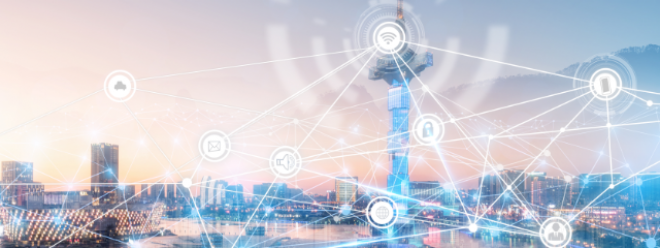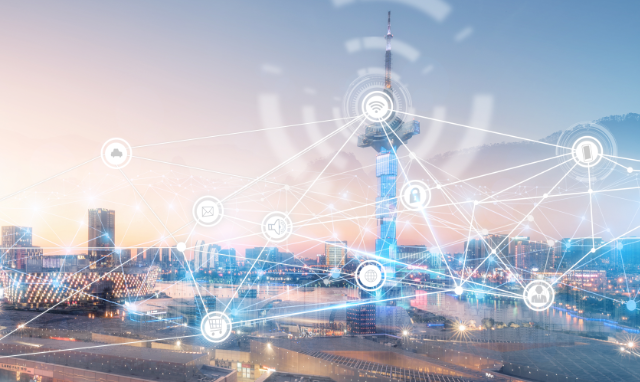IoT and 5G: Changing public transport systems

IoT and 5G: Changing public transport systems

Smart cities collect data from different connected sensors and electronic devices. The development of smart cities relies on the Internet of Things (IoT), information and communication technology (ICT) and strong interconnection.
Fifth generation (5G) wireless mobile communications provide advanced communications networks that connect everything. 5G is an important part of the development of smart cities. It provides the communication infrastructure required for different smart city projects.
Transforming public transportation is one of the main goals of smart city development. In this blog, we highlight the need for smart public transformation systems, the role of 5G and IoT in this, environmental benefits, real-life examples and future aspects.
The need for public transport transformation
Traditional public transportation systems are inefficient and poorly managed. People have to wait for hours at bus stops and often find that the bus they want is full. Due to the increase in population and limited public transportation, traveling by public transportation is considered to be a nightmare. Despite waiting and traveling in a crowded bus, they arrived late at their destination.
Taking these problems into account, transportation authorities in various countries are working hard. They now rely on smart technologies such as IoT and 5G to provide robust public transportation systems.
5G and IoT are game-changers for public transportation systems
5G is the fifth generation of mobile networks that can connect almost anything around the world. It revolutionizes smart cities due to its enhanced connectivity, speed and latency. It can transmit data at approximately 10 Gbps with latency as low as one millisecond.
With 5G, we can transfer data instantly. 5G applications are not limited to providing faster internet for smartphones, but also play a key role in the next generation of intelligent transportation systems.
IoT, on the other hand, is a network of interconnected devices that can communicate and exchange data. It can transform transportation systems by transforming ordinary vehicles into data-driven smart assets. We can embed sensors, IoT devices and GPS systems into buses and trains to connect systems and transmit data.
The collaboration of IoT and 5G is a basic requirement for the development of smart cities and can create miracles for people's high-quality life.
What is an intelligent public transportation system?
The smart public transport system is a connected solution that allows passengers to enjoy their journey easily and conveniently. The main elements of a smart public transportation system include 5G, cloud computing, smart bus stops, smart buses, and remote users using mobile or web applications.
Users can get real-time bus schedules and trajectories, allowing them to reserve seats in advance and arrive at the bus stop on time. They can set up their profile on the mobile app to choose from different packages and discounts. Their accounts are also linked to a bank or credit card, and fares are automatically debited.
The smart bus station also displays all information on the screen for the convenience of passengers. All these systems are connected via 5G, IoT and cloud computing to ensure high system capabilities, accuracy and durability.
Benefits of Transitioning the Mass Transit System
The synergy of 5G and IoT brings many benefits to public transportation. The most interesting ones are discussed here:
1. Cooperate with smart parking
Smart public transport systems can also collaborate with smart parking solutions. When public transit administrators get smart parking opportunities, they can easily park their buses. They can reserve and pay for parking online. Additionally, they can see through the mobile app whether another bus is parked or departing and can manage the route accordingly.
In addition, combined data from both systems allows for in-depth analysis of traffic patterns, providing statistics on areas requiring high mobility, parking spaces and the number of buses. Therefore, this information contributes to the development of smart infrastructure.
2. Smoother commuting
With IoT and 5G, we can design a smart public transportation system. The Smart Bus Tracker mobile app allows users to view available buses or trains on their route. They can find and book via their phone instead of looking in person.
Not only that, they can also pay online at their convenience on a weekly, daily or monthly basis. Students can also get different discounts and packages to make their public transportation experience quite reasonable and appropriate.
3. Real-time update
IoT provides real-time monitoring, allowing users to track the buses they have booked. With GPS tracking and real-time estimates, they can monitor how long it takes for buses to reach nearby stops. Therefore, they can reach the station without long waits.
4. Seat reservation
One of the main problems with public transportation is the lack of seats. Passengers are constantly standing in a suffocating environment, causing fatigue, stress and exhaustion. Even due to close interactions, there is an increased chance of airborne disease transmission.
With smart public transport systems, you can book your seats online and find bus schedules and routes easily. You can easily find a seat without any hassle and if the seats are full no one will be allowed on the bus.
5. Traffic management
When a strong and convenient public transportation system exists, people prefer buses to individual rides. It saves money and reduces traffic congestion and fuel consumption.
In addition, we can also manage passenger demand by releasing buses based on the number of reservations. Passengers do not stay at the bus stop for too long to ensure that all seats are occupied, and passengers do not need to stand on the bus.
Environmental benefits brought by synergy between 5G and IoT in transportation
The synergy of IoT and 5G has positively contributed to smart public transportation systems and played an important role in creating an eco-friendly environment. The environmental benefits are:
1. Traffic jam
The main reason to revolutionize the public transport experience is to reduce traffic congestion. Buses and trains can carry more people and take up less road space.
2. Greenhouse gas emissions
According to a UCLA report, public transportation helps reduce greenhouse gas emissions by up to 45% compared to private cars. Therefore, the authorities must work towards building a strong public transport system.
3. Eco-driving assistance
Smart public transport systems provide drivers with real-time feedback on their driving behavior, such as speed, acceleration and tickets. Monitoring data encourages them to adopt environmentally friendly practices, thereby reducing fuel consumption.
4. Air pollution
Smart public transport systems help improve air quality by reducing the number of vehicles on the road. It must be implemented in areas with severe air pollution.
Real-life examples of smart public transport systems
One of the best examples of smart public transportation systems is in Seoul, South Korea. Their metro system has smart payment and booking systems, Wi-Fi, 5G and virtual assistance. They have climate controlled subways with seat heaters. In addition, there are digital terminals at the station through which passengers can look up bus routes and timetables.
To provide a wonderful experience for passengers, the stations feature virtual grocery stores that look just like real store shelves with images of products and prices. Each product has a logo with a QR code, so buyers can scan the product to shop and have the order shipped to their pre-order address.
Another breakthrough is the launch of a mobile app for public transit users by New York's Metropolitan Transportation Authority (MTA). The app is currently undergoing BETA testing to provide the best traffic experience. Key features of the app include real-time service alerts, scheduling, favorite route saving, real-time bus tracking, trip booking, and more. With this app, passengers can book public transport with just one click, thereby helping to improve the public transport system.
Next generation smart public transportation
In the future, we can see the integration of advanced technologies in smart public transportation systems, including artificial intelligence, holograms, virtual assistance, augmented reality, etc. Additionally, 5G is being upgraded to 6G, offering greater connectivity, frequency, and sustainability. Integrating these technologies will do wonders to provide commuters with the best possible experience.
Summarize
One of the main demands of dealing with the hassles of everyday life is travel. Public transportation is one of the most common ways to commute because of its affordability. 5G and IoT are major assets to revolutionize public transportation systems.
5G provides strong internet connectivity while IoT allows connecting different IoT devices and sensors. The smart public transportation system provides citizens with a smoother commuting experience.
With real-time updates and monitoring, they can book bus seats and arrive at the bus location on time. Affordable and convenient for commuters, smart public transport systems help reduce traffic congestion, pollution and the hassle of everyday work.